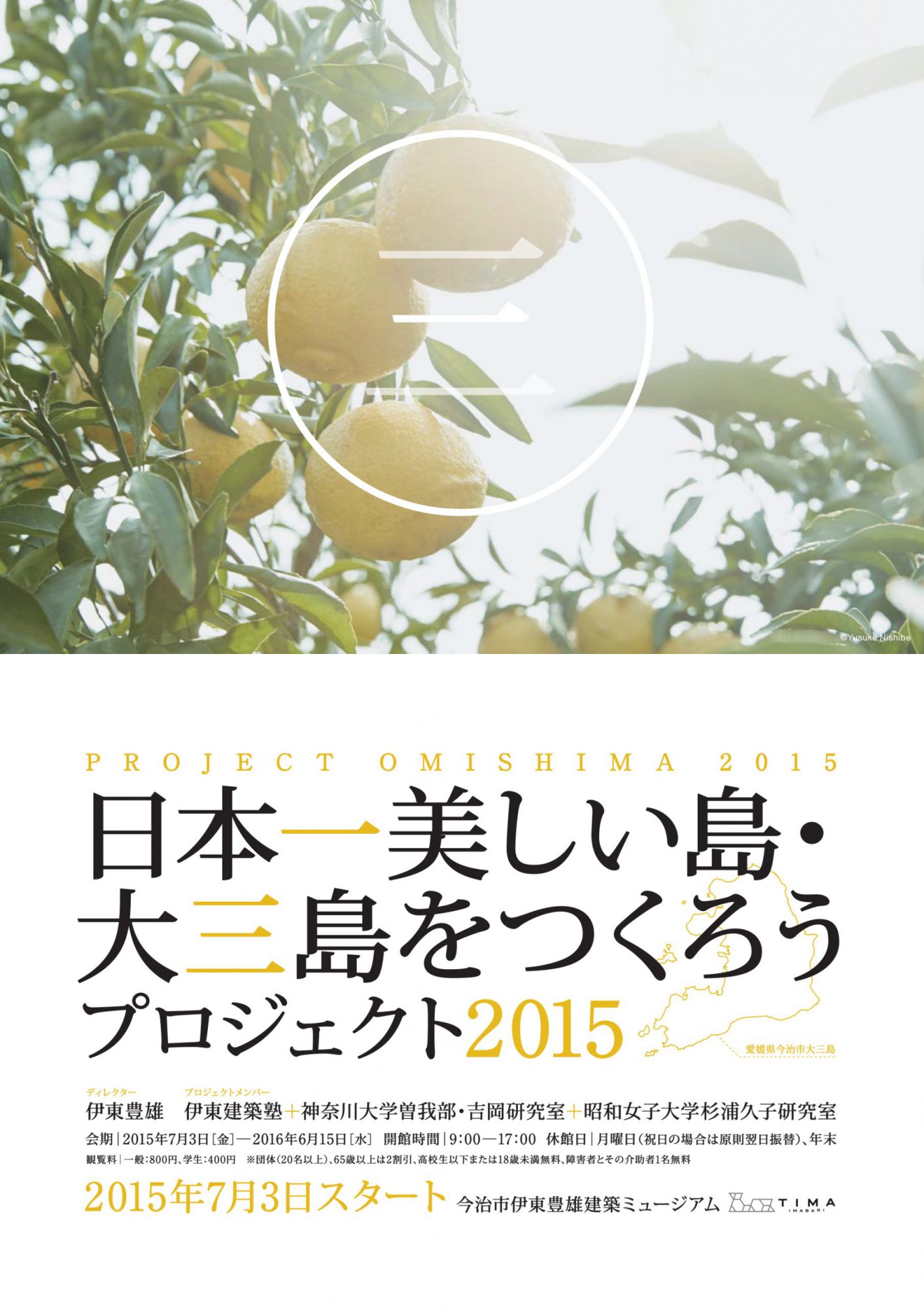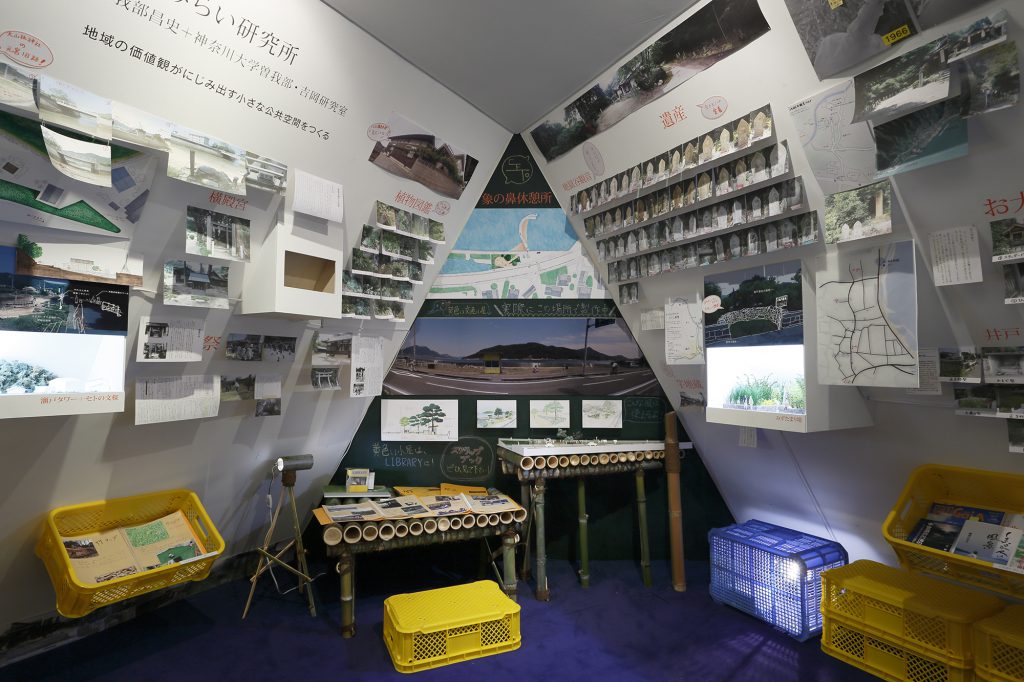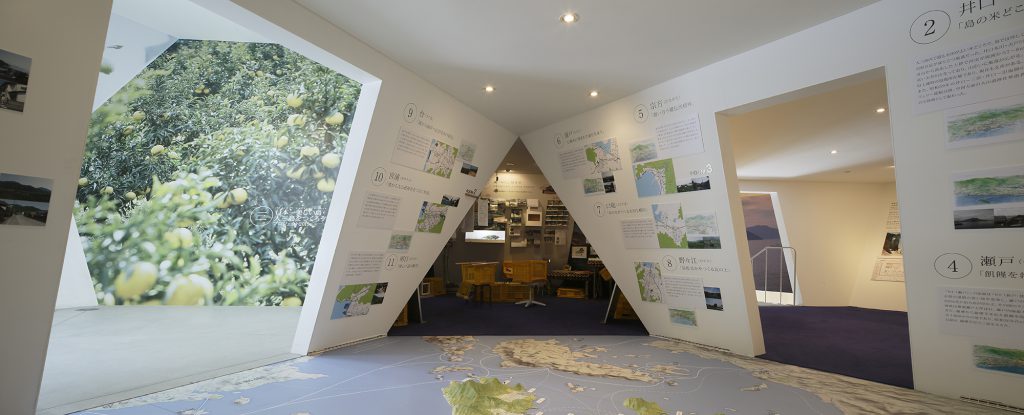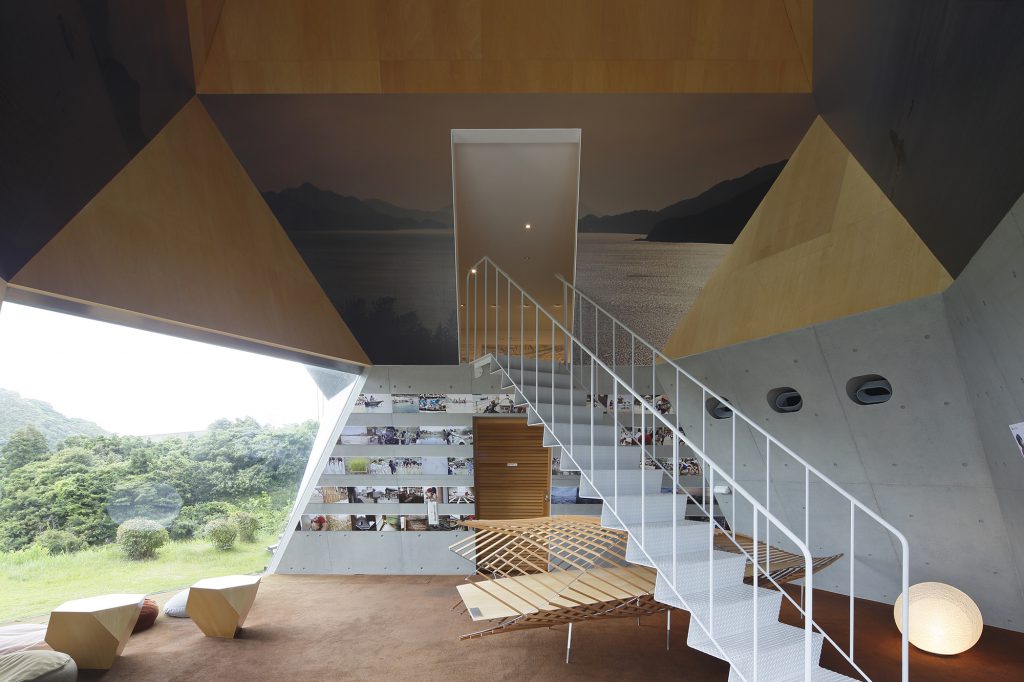
-
Exhibition vol.5
2015.7.3_2016.6.15






© Kai Nakamura
日本一美しい島・
大三島をつくろうプロジェクト2015
会期:2015年7月3日(金)〜2016年6月15日(水)
瀬戸内の美しい多島海の中央に位置する大三島は、人口約6,200人を有する、瀬戸内海で5番目に大きな島です。温暖な気候に恵まれ、みかんを中心とした農業が盛んで、冬から春にかけてはさまざまな種類の柑橘が景色を彩ります。また、島の中心部には日本総鎮守と呼ばれる大山祇神社が鎮座し、歴史ある「神の島」としても知られています。
この地に日本初の建築ミュージアムとして開館した今治市伊東豊雄建築ミュージアムにて開催中の展覧会「日本一美しい島・大三島をつくろうプロジェクト」は、今夏、展示の一部をリニューアルします。伊東豊雄が塾長を務める伊東建築塾の塾生有志が2012年から始めたこのプロジェクトは、2014年から神奈川大学曽我部昌史研究室や昭和女子大学杉浦久子研究室も加わり、島の各地で、人びとが集える小さな場所づくりに取り組んでいます。本展では、こうしたプロジェクトの進捗を紹介するとともに、島の景色や人びとの営みを伝える写真や映像も展示します。
太陽と海の恵みを享受しながら長い歴史を刻んできたこの島には、海と山に囲まれた美しい風景、潮風を浴びて育った柑橘、そして自然と共にある人びとの暮らしが、今もなお脈々と受け継がれています。ぜひ実際に大三島を訪れて、こうした島の魅力を堪能していただければ幸いです。
2011年に今治市伊東豊雄建築ミュージアムが開館して以降、度々大三島を訪れるようになりました。同時期に立ち上げた伊東建築塾の塾生たちも、島を訪れた際、自然に接して暮らす人びとの活き活きとした姿に心を打たれ、自主的に島に通うようになりました。初めて島を訪れた人の多くが魅了されてしまうような不思議な力が、この地には確かに存在していると感じています。私はこの大三島という素晴らしい地域に場所を定め、多くの若い人びとの力を借りて、これから長い時間をかけて島づくりに取り組むことを決意しました。経済の豊かさよりも心の豊かさを求めるようになった今、私たちは地域に目を向け、自然に開かれた生活を考える時期を迎えています。地域の人びとと語りあい、一緒に新しいライフスタイルをつくることこそが、今求められているのです。
伊東豊雄
English
Project Omishima 2015-Transforming into the most beautiful island in Japan
July 3, 2015 (Fri) – June 15, 2016 (Wed)
Omishima is located in the middle of the necklace of islands in the Inland Sea. With approximately 6200 people living on the island, it is the fifth largest island in the region. The warm climate makes it a perfect place to farm mandarins, and from winter through spring, you can enjoy a variety of species that dapple the landscape in infinite shades of orange. It is also known for its deep local history and Oyamazumi Shrine that houses Chinjugami (the God of Land), and hence Omishima is known to some as an “Island of Divinity.”
In 2011, Japan’s first architecture museum, Toyo Ito Museum of Architecture, Imabari (TIMA) opened on this sacred island. This summer, we curated a new exhibition “Project Omishima – Transforming into the most beautiful island in Japan” as a part of the museum’s exhibition series. The Omishima Project started in 2012 with Ito Juku (the Specified Nonprofit Corporation “Initiative for Tomorrow’s Opportunities in Architecture”), and joined later by Studio Sogabe and Yoshioka (Kanagawa University, school of architecture) and by Studio Sugiura Hisako (Showa Women’s College) in 2014. Together, we have developed places on this island for the local residents to gather. In addition to showcasing these developments of this project, we are introducing the island’s landscapes and people’s lives via photographic and video works. The island enjoys the blessings of the sun and the sea while building upon its historical engravings. To this day, Omishima continues to be embraced by the picturesque mountains and sea; the mandarins cultivated with the warm sea breeze and residents with lifestyles that are connected with nature. We invite you to come visit Omishima and to fully experience her hidden gems.
Since the Toyo Ito Museum of Architecture was opened in Imabari City in 2011, I have frequently visited Omishima. When the students of Ito Juku, which opened at the same time, visited the island, my heart was struck by the lively sight of them coming into contact with nature and the people living there, as they freely wandered through the island. Most of the people that visit the island for the first time really feel that there is a strange power in this place that fascinates them.
According to a survey carried out by the Cabinet Office last year about 40% of the residents of Tokyo would move to a provincial area if given the opportunity. Also just under 30% of the people want a residence in both the city and a rural area. This data positively indicates that the number of people that feel more attracted to living in a rural area in contact with nature than in an artificial environment such as Tokyo is increasing.
Today when riches of the heart are sought more than economic riches, we are approaching a time when we are looking towards rural areas, and considering a lifestyle that is open to nature. The idea about living on an island is not simply the idea of the lifestyle of the island people, but is the idea of what is to be our lifestyle in the future.
I have picked this wonderful location of Omishima to undertake with the help of many young people island development over a long period of time. What is needed now is to work together to create a new lifestyle through discussions with the local people.
Toyo Ito


動画:日本一美しい島・大三島をつくろうプロジェクト2015
https://www.youtube.com/watch?v=HA_8hLVN9mA

瀬戸/象の鼻休憩所
Seto/ Zo No Hana Recreation Center

宮浦/大三島の「みんなの家」
Miyaura/Omishima Minna-no-Ie (Omishima“House for Everyone”)

宗方/船ノウチ
Munagata/Fune-no-Uchi(Boat House)
Restored rowing boat space proposal(Munagata Bar)

大島/石のカフェ
Oshima/Ishi-no-Café(Stone Café Design Project)
大三島には13の集落があります。今でこそ陸路が整備され、集落間の往来は容易になりましたが、かつては海上交通が中心で、島内よりも周辺の島々との交易が盛んだったこと、また、海や山の間の限られた土地に集落を築いてきた結果、集落ごとに少しずつ異なる文化や生活習慣が形成されてきました。本展では、13の集落の紹介に始まり、プロジェクトルームでは「瀬戸」「宮浦」「宗方」の3つの集落と、大三島からしまなみ海道でつながる「大島」における“人びとが集える小さな場所づくり”のプロセスを紹介します。集落に点在する空き地や空き家を活用したり、島の伝統文化に寄り添う空間や地場産業を発信するカフェを建設したり、島内外の人びとがゆるやかに交わる多様な場所のつくり方を示します。






© Kai Nakamura
主催:
今治市、今治市教育委員会、NPOこれからの建築を考える 伊東建築塾
助成:
公益財団法人朝日新聞文化財団
協力 伊東豊雄建築設計事務所、海sora&花結び、愛媛県立今治北高等学校大三島分校、大三島ふるさと憩の家、上浦町地域おこし協力隊、菅 昭十四、kiki’s苺ハウス、Jishac、株式会社しまど、NPOしまなみアイランド・スピリット、しまなみイノシシ活用隊、青陽建築設計工房、多田脩二構造設計事務所、旅館 茶梅、鍋島悠弥、NPO能島の里、花澤家族農園、べじべじ自然農園、三島電業社、吉川 努、移動カフェ ロコバス
ディレクター:
伊東豊雄
アソシエイトディレクター:
高野洋平、古川きくみ、吉岡寛之
プロジェクトメンバー:
伊東建築塾(荒武優希、粟野寿朗、イトウジュン、大崎雅洋、木戸正典、木平岳彦、木村真緒、小迫欣弘、小森陽子、鈴木ますみ、須永 杏、須永泰由、瀬戸洋樹、高橋千里、千野和博、辻 美和、中村鈴子、西山和臣、長谷川欣則、俵谷知英子、南 宣宏、吉田祐介、吉村隆之)、曽我部昌史+神奈川大学曽我部・吉岡研究室、杉浦久子+昭和女子大学杉浦久子研究室
写真:
西部裕介、高橋マナミ、山田宗草
映像:
田中英行
音楽:
石田多朗
グラフィックデザイン:
丸山智也
※詳細は、下記PDFデータをご覧ください。
English
Organizers :
Imabari City, Imabari City Board of Education,
NPO Initiative for Tomorrow’s Opportunities in architecture, Ito Juku
Supporters :
Asahi Shimbun Foundation
Cooperation: Toyo Ito & Associates, Architects, Umi Sora & Hanamusubi,
Ehime Prefectural Imabari City High School Omishima Campus,
Omishima Furusato Ikoi No Ie, Kamiura Town Local Cooperative, Akitoshi Kan,
Kiki’s Strawberry House, Jishac, K.K. Shimado, NPO Shimanami Island Spirit,
Shimanami Inoshishi Katsuyotai, Haruaki Architectural Design Studio,
Tada Shuji Structural Design Office, Ryokan Chabai, Yuya Nabeshima,
NPO Noshima No Sato, Hanazawa Family Farm, Natural Farm Vegi-Vegi,
Mishima Dengyosha, Tsutomu Yoshikawa, Mobile Café Locobus
Director :
Toyo Ito
Associate Directors :
Yohei Takano, Kikumi Furukawa, Hiroyuki Yoshioka
Project members :
Ito Juku (Yuki Aratake, Jiro Awano, Jun Ito, Masahiro Osaki,
Masanori Kido, Takehiko Kihira, Mao Kimura, Yoshihiro Kosako, Yoko Komori,
Masumi Suzuki, Kyo Sunaga,Yasuyoshi Sunaga, Hiroki Seto, Chisato Takahashi,
Kazuhiro Chino, Miwa Tsuji, Suzuko Nakamura, Kazuomi Nishiyama,
Yoshinori Hasegawa, Chieko Hyotani, Yosihihiro Minami, Yusuke Yoshida,
Takayuki Yoshimura),
Masashi Sogabe + Kanagawa University Sogabe/Yoshioka Laboratory,
Hisako Sugiura + Hisako Sugiura Laboratory, Showa Women’s University
Photography :
Yusuke Nishibe, Minami Takahashi, Munekusa Yamada
Filming :
Hideyuki Tanaka
Music :
Taro Ishida
Graphic design :
Tomoya Maruyama
Please refer to the attached file for further information.
Project Omishima 2015-Transforming into the most beautiful island in Japan



